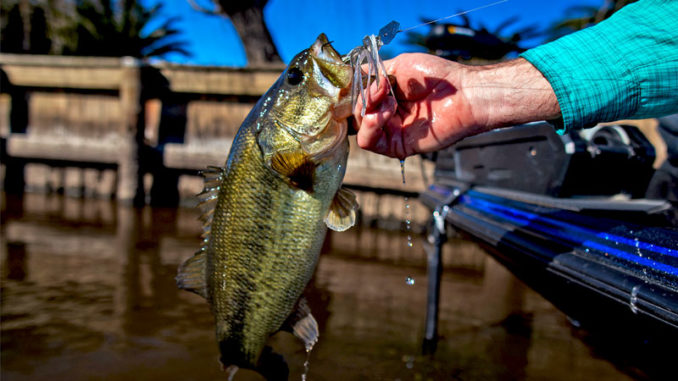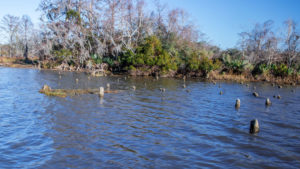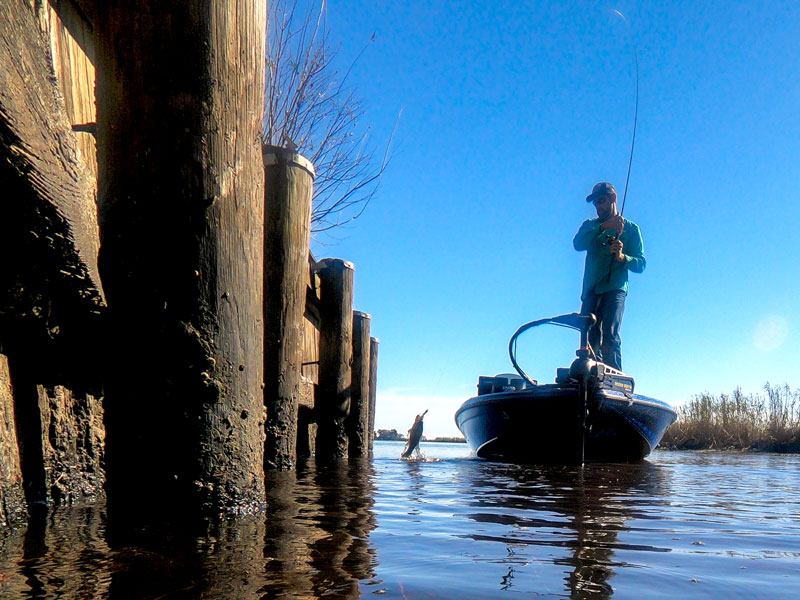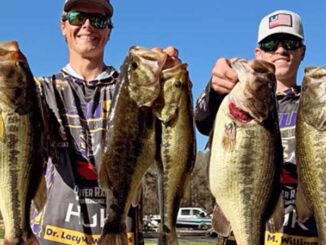
The warmest water around on a late-winter or early spring day will be right against wood that’s been taking in direct sunlight. And that’s one place the bass will be.
It was my best bass-fishing trip ever. I was 19, it was the middle of the afternoon, and I had just gotten home with a brand-new rod and reel. It was early March, and it was very cold.
I slowly paddled down the canal, casting along the shoreline using a Beetle Spin. I wasn’t concentrating all that much on the fish, but more on the performance of my rod and reel. I approached a point that was lined with pilings.
The pilings were set about 5 feet apart, and they completely surrounded the small peninsula. My lure dropped just past a set of pilings, and as I reeled it past, I had a hit. I set the hook and reeled it in, still concentrating more on my new toy rather than trying to find a pattern. I unhooked the 12-inch bass, tossed it back, and flung the Beetle Spin right back in between the pilings. The same thing happened. The third turn of the handle, and another bass jumped on.

I was liking my new setup, but after I put another bass in the boat on my third cast, my attention shifted to trying to catch a limit. Well, that limit came quickly, and after an hour, I must have caught and released more than 20 fish.
That afternoon is etched in my memory, and I could never come up with a reason for those bass being so concentrated in one area. When I told the story, I always ended with the same exclamation, “I have no idea why!”
Fast forward 27 years. I told the story to tournament angler Chris Basey of Covington. Fortunately, he’s fished the same spot numerous times. All he had to do is ask me two questions, and I finally knew why I caught so many fish that afternoon. The first one was, “Was it cold that day?” The second being, “Was it sunny?”
“When you’re dealing with cold water, you always want to try and find water that’s warmer,” Basey said. “On a cold day, when the sun is shining bright, that’s the perfect time to seek out wooden pilings or bulkheads.”
The colder the better
Cold weather isn’t something anglers such as Basey have to worry about all that often in the Bayou State, but there are days when he specifically targets structure that has been soaking up the sun.
“If I see that the forecast calls for a high of 50 degrees or lower, I know what my strategy is going to be,” he said.
While the magic number for Basey is 50, he said that the rule works even better when the temperatures dip into the 40s.
“The colder the better. These fish down here are southerners, just like us, and not used to dealing with ultra-cold water,” he said. “Their top priority is going to be finding warmer water.”
Baitfish
During a recent tournament, Basey had the chance to witness first-hand the effects of sun-soaked wood. He was cruising past a bulkhead and saw something that stood out on his electronics.
“That bulkhead was loaded with baitfish that were clinging to the face of the structure,” he said.

Basey eased in and made a few casts horizontally along the bulkhead and started catching bass that were there to ambush the baitfish. He said the warm water was serving two purposes: it attracted smaller baitfish that were seeking warmer water, and that attracted the bass.
“It’s the perfect scenario for bass: the water is warmer, and there’s a buffet waiting for them,” he joked.
The experiment
While fishing in the East Pearl River one sunny, cold day, Basey brought along a simple, floating thermometer. He tied the thermometer to the tip of his rod and extended it towards the bulkhead. He placed it in the water within an inch of the wood and checked the reading after 30 seconds: 54 degrees. Next, he dropped the thermometer 6 inches from the pilings, and after 30 seconds, got a reading of 52 degrees. He took three more readings, placing the thermometer a foot, 3 feet and 5 feet away from the bulkhead. The temperature readings were 49, 48 and 48 degrees respectively.
The takeaway was clear. While the wood did heat up the water, it only was able to affect the water within very close by — within a foot or so. While it was a simple experiment, it has changed the way Basey fishes in terms of where he places his casts. It’s important to put your lure as close to that wood as possible, and doing so has made for some successful days.
While targeting bass next to sun-soaked structure on cold days should be in your game plan, Basey said that there is one factor that can nullify the effects: current. He recommends finding canals and cuts that are off of any main river where a swift current might be found.


